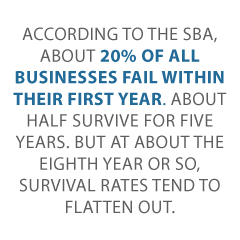Is a Business Bankruptcy in Your Business’s Future?
If your business is having issues, business bankruptcy might be on your mind. But before you go ahead, there are some things you should know.
Business Failures
No one likes to think about it, but there’s a chance your business just plain won’t catch on. Maybe no one will buy your products or services, or expenses like rent could drive you out of business, or mismanagement could do your business in.
According to the SBA, about 20% of all businesses fail within their first year. About half survive for five years. But at about the eighth year or so, survival rates tend to flatten out.
Business Failures and the Economy
Before Covid-19, a bad economy didn’t really impact survival rates. Per the SBA, a boom or a bust economy didn’t really change things. But in July of 2020, per the New York Times, the number of small business failures was likely over 100,000.
Business Failures and Industries
Before Covid-19, the SBA said industries didn’t matter too much when it came to business failure rates. But food services and hotels tended to do better then. Not so during the age of Covid-19. Lockdowns and the need to work from home have taken their toll.
Business Failures, Industries, and Covid-19
Per Business Insider, the hardest hit industries are:
- Hotels, restaurants, bars, amusement parks, and casinos
- Sporting events, the performing arts, and scenic transportation (boat tours, etc.)
- Home furnishings stores and clothing stores
- Motion picture and sound recording
- Dental offices, and
- Laundry and other personal services
Business Failures: The Reasons Why
Before Covid-19, FreshBooks said these are the top reasons why a business might fail:
- Not enough demand
- Lack of cash
- Dysfunctional team
- Competition
- Pricing issues
Business Futures During Covid-19
According to the National Academy of Sciences, a July 2020 survey of over 5,000 small businesses (not just science-based) revealed, if a business had more cash on hand, its ownership was more confident they would stay in business. Then again, nearly all of the entrepreneurs surveyed believed the crisis would be over before January 1, 2021.
Business Bankruptcy
Bankruptcy is a process a business goes through in federal court. It is designed to help a business eliminate or repay its debt under the guidance and protection of the bankruptcy court. Business bankruptcies are often described as liquidations or reorganizations. This depending on the type of bankruptcy an entrepreneur takes.
3 Types of Business Bankruptcy
There are three types of business bankruptcy:
- Chapter 7
- Chapter 11
- and Chapter 13
These types depend on organizational structure.
Chapter 7 and Chapter 11
Corporations and partnerships are legal business entities separate from their owners, although corporations are more truly separate than partnerships. Either type of structure commonly will file of Chapter 7 (bankruptcy protection), or Chapter 11 (reorganization). The chapters refer to the US Bankruptcy Code.
Chapter 7: Liquidation
This one may be the best choice when the business has no viable future. It is typically for when the debts of the business are so overwhelming that restructuring them is not feasible. Chapter 7 bankruptcy can be for sole proprietorships, partnerships, or corporations. It is also appropriate when the business does not have any substantial assets.
If a business is a sole proprietorship, and an extension of an owner’s skills, it usually does not pay to reorganize it. Hence Chapter 7 is appropriate.
But before a Chapter 7 bankruptcy gets approval, the applicant is subject to a means test. If their income is over a certain level, their application does not get approval. But if a Chapter 7 bankruptcy gets approval, the business is dissolved.
Working with a Trustee in a Chapter 7 Business Bankruptcy
In a Chapter 7 bankruptcy, a trustee is appointed by the bankruptcy court. The trustee’s job is to take possession of the assets of the business and distribute them among the creditors. The order in which creditors are paid can depend on the type of debt (secured vs. unsecured).
After the assets are distributed and the trustee is paid, a sole proprietor receives a “discharge” at the end of the case. This means that the owner of the business is released from any obligation for the debts. But partnerships and corporations do not receive a discharge.
Chapter 11: Business Reorganization
Chapter 11 may be a better choice for businesses that may have a realistic chance to turn things around. It is usually for partnerships and corporations. It is also for sole proprietorships if their income level is too high to qualify for Chapter 13 bankruptcy.
Chapter 11 is a plan where a company reorganizes and continues in business under a court-appointed trustee. The company files a detailed plan of reorganization outlining how it will deal with its creditors. The company can terminate contracts and leases, and recover assets. And it can repay a portion of its debts, while discharging others to return to profitability.
The business presents the plan to its creditors who will vote on the plan. If the court finds the plan is fair and equitable, it will approve the plan. Reorganization plans provide for payments to creditors over some time. Chapter 11 bankruptcies are very complex and not all of them succeed. It usually takes over a year to confirm a plan.
Chapter 11 and the Small Business Reorganization Act of 2019
The Small Business Reorganization Act of 2019 enacted a new subchapter V of Chapter 11. The act went into effect as of February 20, 2020. This subchapter of Chapter 11 seems to favor the side of the applicant for business bankruptcy. But it only applies if the applicant wants it to apply.
For example, subchapter V does not require the appointment of a committee of creditors. And it doesn’t require for creditors to approve a court plan.
Per the US Department of Justice, the act: “imposes shorter deadlines for completing the bankruptcy process, allows for greater flexibility in negotiating restructuring plans with creditors, and provides for a private trustee who will work with the small business debtor and its creditors to facilitate the development of a consensual plan of reorganization.”
Chapter 13: Adjustment of Debts for Individuals with Regular Income
Since a sole proprietorship is an extension of its one owner, the owner is responsible for all assets and liabilities of the firm. It is most common for a sole proprietorship to take bankruptcy by filing for Chapter 13. This is a reorganization bankruptcy.
Chapter 13 is for small businesses when a reorganization is the goal instead of liquidation. The entrepreneur files a repayment plan with the bankruptcy court. This details how they are going to repay their debts. But note that Chapter 13 and Chapter 7 bankruptcies are very different for businesses.
Chapter 13 is vital for individuals whose personal assets are tied up with their business assets. This is because they can avoid problems like losing a home if they file Chapter 13, instead of Chapter 7. And Chapter 13 lets a business stay in business and pay its debts, while Chapter 7 does not.
Preventing Bankruptcy
You can’t prevent every bankruptcy. But for the ones where a lack of cash is the issue, getting access to more money can pull a business out of the hole. Many entrepreneurs may not even realize where they can get cash.
Preventing Bankruptcy: Access to More Cash
Entrepreneurs may feel their only options are to go to a big, traditional bank, or turning to their family and friends for a handout. But it doesn’t have to be that way! There are all sorts of alternative ways to get money. Let us help you navigate them and keep YOUR business afloat.
Business Bankruptcy: Takeaways
Many businesses fail within the first five years of operation. There are many causes, and the Covid-19 crisis has only made things worse. There are three forms of bankruptcy a business can file for, although Chapter 13 is just for sole proprietors. Chapters 7 and 11 are for sole proprietors, partnerships, and corporations
For corporations and partnerships, the choice between Chapter 7 and Chapter 11 is the choice between liquidation and reorganization. For both Chapter 7 and Chapter 11 bankruptcies, there’s the appointment of a trustee. But in Chapter 7, the trustee distributes remaining assets among the creditors. And in Chapter 11, the trustee works with a plan to reorganize the business in order to try to save it. We can help you avoid a business bankruptcy if a lack of cash is your problem. Let’s weather the storm together.

